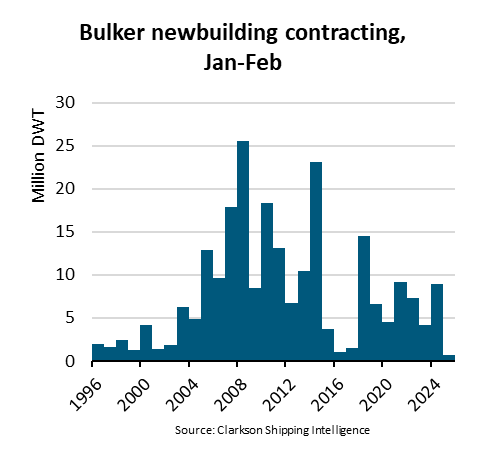
U.S. soybean exports have been historically sluggish in recent months, but although industry expectations are already low, full-year shipments are in danger of falling even further without more bookings from China.
Based on data published on Tuesday by the U.S. Census Bureau, the United States shipped 2.57 million tonnes of soybeans in March, a five-year low for the month and down 31% from last year’s record.
Shipments to China totaled just 208,505 tonnes, the lightest for March since 2002 and the lowest volume for any month since December 2018. That brought combined February and March exports to China to the lowest for the period since 1999.
U.S. soybean exports to China improved in April, likely landing in the vicinity of 400,000 tonnes as suggested by weekly export inspection data, but that would still be the lightest for April in four years. U.S. shipments to China are normally small during this time as Brazil is usually doing all the business, but the trade war has caused irregular U.S. purchasing patterns by the Chinese for nearly two years.
Inspection data indicates that April soybean shipments fell slightly short of the March figure. The best-case scenario for April would put exports from September through April, the first seven months of 2019-20, at about 35.5 million tonnes or 1.3 billion bushels. Worst-case is about 2% lower.
The U.S. Department of Agriculture’s latest estimate of 2019-20 U.S. soybean exports is 48.3 million tonnes or 1.775 billion bushels. That means that 12.8 million tonnes are left to ship in the final four months in the best-case scenario, an average of 3.2 million per month.
That would be the third largest May-through-August volume on record behind the previous two years, so logistically, it is not unreasonable. But sufficient sales will be the primary hurdle.
U.S. soybean sales for 2019-20 totaled 39.7 million tonnes or 1.46 billion bushels as of April 30, so bookings must reach 8.6 million tonnes between May and August to hit USDA’s mark. That is more than double the sales during the same period in the previous three years.
Record U.S. sales in the final four months of 2019-20 are possible, but only China holds the power to make it happen, especially given the commitments outlined in the Phase 1 trade deal. But the world’s top soybean importer is about to be inundated with supply from Brazil, which just had a blockbuster April in terms of exports.
There may not be a ton of room to expand sales to other buyers, at least not enough to make up for any Chinese shortfalls. The United States shipped 20.6 million tonnes of soybeans to non-China destinations between September and March, down from the prior year’s huge anomaly but up notably from other recent years.
CORN IMPROVING
U.S. corn exports totaled 4.62 million tonnes in March, the largest monthly total since May 2019 but below the recent March average.
Inspections imply that April shipments were just as good, if not slightly better than in March, and the best-case scenario for April would place cumulative 2019-20 exports at 25.4 million tonnes or about 1 billion bushels, with the low-end scenario some 2% less.
USDA has 2019-20 U.S. corn exports at 43.8 million tonnes or 1.725 billion bushels, a seven-year low. That means that shipments in the final four months must average between 4.5 million and 4.7 million tonnes per month, which is below the recent five-year average but above the 10-year.
Through April 30, sales for 2019-20 totaled 37.5 million tonnes, meaning some 6.3 million tonnes in sales are still needed. The five-year average for May-through-August corn sales is just over 7 million tonnes, so the target is reasonable.
That is especially so since current U.S. export prices for corn are just about as competitive as they have been this entire marketing year versus other suppliers.
A good dent has already been made in that 6.3 million-tonne requirement during the first week of May. Daily corn sales have totaled 532,020 tonnes since May 4, at least 70% of which were to China.
USDA on Tuesday will issue official outlooks for 2020-21, and although corn export projections are almost certainly likely to rise from the current marketing year based on increased availability, they will not prevent stockpiles from swelling to extraordinary highs.
Analysts see U.S. corn ending stocks for 2020-21, or the inventory on Sept. 1, 2021, at 3.389 billion bushels, the biggest since 1987-88 and nearly 50% more than the largest stockpile since 1988.
The opinions expressed here are those of the author, a market analyst for Reuters.
Source:Reuters
The opinions expressed herein are the author's and not necessarily those of The Xinde Marine News.
Please Contact Us at:
media@xindemarine.com


 Ningbo Containerized Freight Index Weekly Commentar
Ningbo Containerized Freight Index Weekly Commentar  Ningbo Containerized Freight Index Weekly Commentar
Ningbo Containerized Freight Index Weekly Commentar  Ningbo Containerized Freight Index Weekly Commentar
Ningbo Containerized Freight Index Weekly Commentar  BIMCO Shipping Number of the Week: Bulker newbuildi
BIMCO Shipping Number of the Week: Bulker newbuildi  Ningbo Containerized Freight Index Weekly Commentar
Ningbo Containerized Freight Index Weekly Commentar  Ningbo Containerized Freight Index Weekly Commentar
Ningbo Containerized Freight Index Weekly Commentar